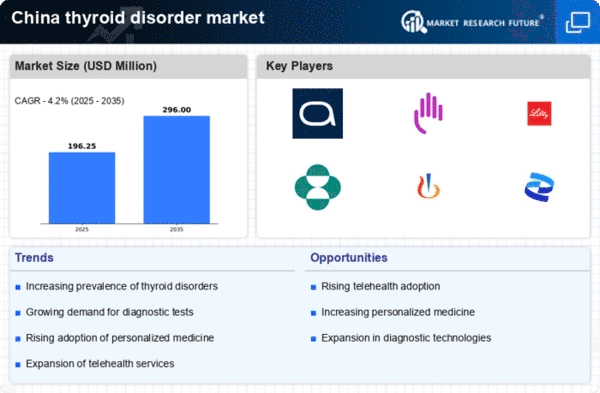Rising Geriatric Population
The demographic shift towards an aging population in China is significantly impacting the thyroid disorder market. Older adults are more susceptible to thyroid disorders, such as hypothyroidism and hyperthyroidism, which are prevalent in this age group. According to recent statistics, the geriatric population is projected to reach approximately 400 million by 2040, indicating a substantial increase in the potential patient base for thyroid-related conditions. This demographic trend is likely to drive demand for diagnostic services, medications, and ongoing management of thyroid disorders. Consequently, pharmaceutical companies and healthcare providers are expected to focus on developing targeted therapies and comprehensive care solutions tailored to the needs of the elderly, thereby enhancing the thyroid disorder market.
Government Initiatives and Support
Government initiatives aimed at improving healthcare access and quality in China are positively influencing the thyroid disorder market. Policies that promote early detection and treatment of thyroid disorders are being implemented, which may lead to increased screening and diagnosis rates. The Chinese government has allocated substantial funding to enhance healthcare infrastructure, particularly in rural areas where access to medical services is limited. This support is expected to facilitate better access to diagnostic tools and treatment options for thyroid disorders. As a result, the market may witness a surge in demand for medications and therapies, contributing to overall growth in the thyroid disorder market.
Increasing Awareness of Thyroid Health
The thyroid disorder market in China is experiencing growth due to heightened awareness regarding thyroid health among the population. Educational campaigns and health initiatives have been instrumental in informing individuals about the symptoms and risks associated with thyroid disorders. As a result, more people are seeking medical advice and diagnostic testing, leading to an increase in diagnosed cases. This trend is reflected in the rising demand for thyroid function tests and related treatments. The market is projected to expand as awareness continues to grow, potentially increasing the number of patients receiving timely interventions. Furthermore, the emphasis on preventive healthcare is likely to drive the thyroid disorder market, as individuals become more proactive in managing their health.
Technological Advancements in Treatment
Innovations in treatment modalities for thyroid disorders are shaping the thyroid disorder market in China. The introduction of novel therapies, including targeted medications and minimally invasive surgical techniques, is enhancing treatment outcomes for patients. For instance, advancements in radioiodine therapy and the development of new antithyroid drugs are providing more effective options for managing hyperthyroidism. Additionally, the integration of artificial intelligence in treatment planning and monitoring is expected to improve patient care. As these technologies become more widely adopted, they may lead to increased patient satisfaction and adherence to treatment regimens, ultimately driving growth in the thyroid disorder market.
Growing Demand for Personalized Medicine
The trend towards personalized medicine is gaining traction within the thyroid disorder market in China. Patients are increasingly seeking tailored treatment plans that consider their unique genetic profiles and specific health conditions. This shift is prompting healthcare providers to adopt more individualized approaches to diagnosis and treatment, which may enhance therapeutic efficacy. The rise of genetic testing and biomarker identification is facilitating the development of customized therapies for thyroid disorders. As patients become more informed and engaged in their healthcare decisions, the demand for personalized treatment options is likely to grow, thereby influencing the overall landscape of the thyroid disorder market.

















Leave a Comment